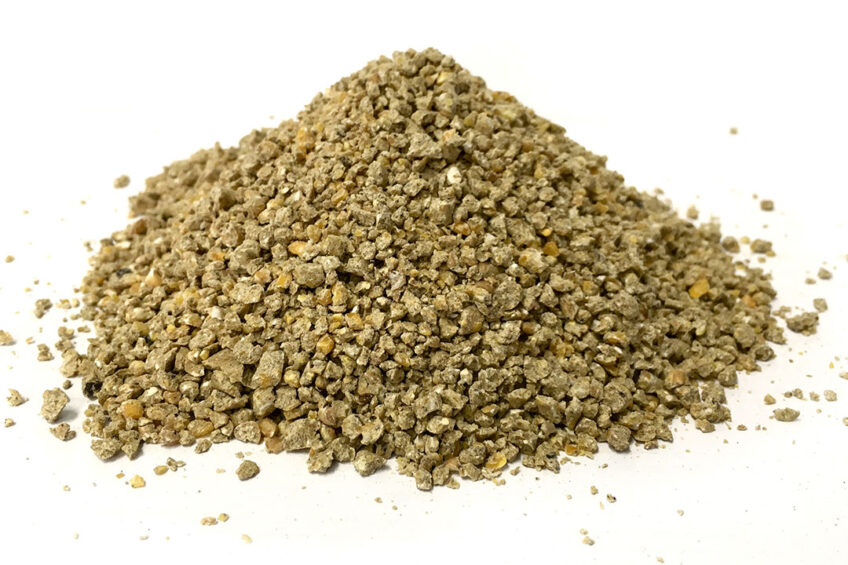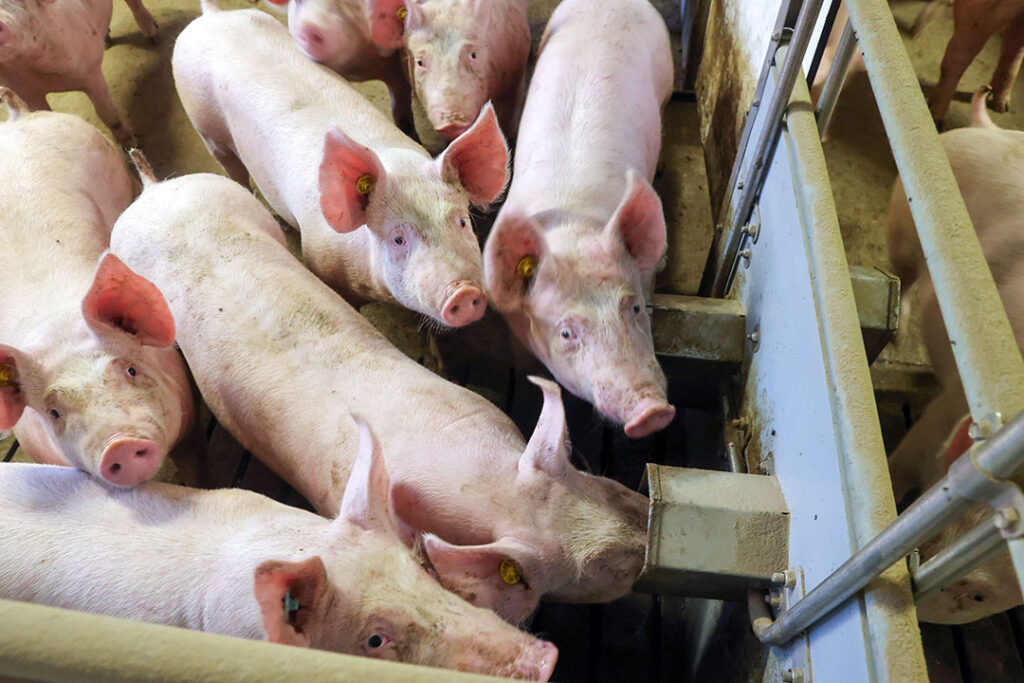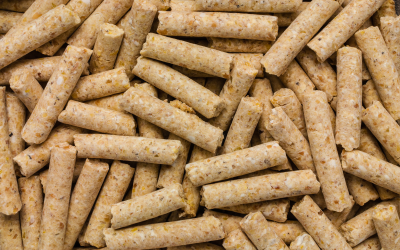Feed pellet particle size and its effect on gut health

Particle size is an important factor that determines feed efficiency and gut health in pigs and poultry. Feed processing therefore need to evolve, with an increased focus on the complex interactions between pellet characteristics, gut health and microbiota.
Advances in genetics has produced commercial strains of poultry and pigs with improved performance (growth, reproduction, etc.) based on minimal feed input. The nutrition of these animals has also evolved over time to achieve and sustain their genetic potential. Examples of advances in monogastric nutrition include the widespread adoption of net energy, ideal ratios of standardised ileal digestible amino acids and digestible phosphorous concepts, enabling nutritionists to formulate cost-effective optimal diets. There is also increased interest in the interaction between feed processing and gut health in animals. A healthy gut is very important when raising pigs and poultry sustainably and profitably, with limited use of antibiotics.
The role of feed processing
Today, most pig and poultry feeds are manufactured by employing a combination of technologies including physical grinding with hammer and/or roller mills in conjunction with hydrothermal processing (HTP) including pelleting, expansion, or extrusion. Pelleting is the most prevalent HTP method for manufacturing pig and poultry diets. During the pelleting process, the feed is passed through steam, which softens the feed particles before they are pressed through the die by the rolls in the pellet press, causing an additional grinding effect. It is well-recognised that processing parameters such as the extent of particle modification, processing temperature, pressure, duration, and water determine the physical and chemical reactions in and between nutrients as well as the adhesive properties on the feed particle surfaces, the final physicochemical structure and the hygiene status of the feed. These attributes can directly and indirectly influence the impact of the processed feed on the digestive tract ecology and thus animal health, performance, and feed cost. Some of the studies that examined the link between processed feed and health effects are listed in Table 1. Effects of smaller particle size include reduced gizzard and pancreas weights in poultry and increased stomach ulceration in pigs.
The effect of particle size
Grinding makes it possible to create different particle sizes. Particle characteristics, particularly size, are one of the most controversial issues in pig and poultry nutrition. From an economic point of view, optimal particle size distribution adapted to the physiological needs of the animal enables optimal utilisation of nutrients and enhances animal performance. Numerous reports show the effects of the feed particle size of cereals on pigs and poultry (Table 2).
Pigs
Pigs fed a coarse diet have heavier stomachs than pigs fed a fine diet, which probably reflects the fact that coarse diets require more muscular action for processing by the stomach than fine diets. Feed particle size was also shown to impact the large intestine. Studies have demonstrated that coarse diets were strongly associated with higher propionic and butyric acid levels in the caecum and colon contents. It is possible that coarse feed particle size may promote an increase in bacteria populations producing short-chain fatty acids (SCFAs) and, thus, contribute to gastrointestinal health by preventing the proliferation and/or virulence of harmful bacteria such as Salmonella spp. and E. coli. Studies have demonstrated that change in feed presentation could be associated with microbiota modification (different composition and/or metabolic activities) in the gastro-intestinal tract (GIT) of pigs. According to literature data, reducing the quantity of fine particles in pig feed is strongly recommended. Generally, based on existing literature the quantity of finer particles (<0.4 mm) should be as low as possible due to the negative effect on GIT health and the quantity of the coarsest fractions (>1.6 mm) should also be low due to reduced nutrient utilisation whereas the proportion of medium-sized particles (>0.5 to <1.6 mm), which are considered optimal for the pig’s digestive system, should be as high as possible.

Poultry
In poultry, the proventriculus and gizzard are the true stomach compartments. Lack of a structural component in poultry diets has been associated with dilated proventriculus and a non-functional gizzard, thus compromising feed utilisation and intestinal health. It has been reported that the volume of the gizzard may increase substantially when structural components such as whole or coarsely ground cereals are added to the diet, sometimes increasing to more than double the original size. Feed particle size may also affect the physiological and morphological characteristics of the GIT and thus microbial status. Finely ground feed stimulates faster growth of Clostridium perfringens than coarsely ground feed and can hence be a risk factor for Necrotic enteritis (NE). Earlier studies observed that birds fed a coarsely ground wheat diet had 18.1% mortality due to NE, whereas birds fed a finely ground wheat diet had 28.9% mortality. This was linked to coarse feed stimulation of gastric function, including secretion of HCl and better utilisation of nutrients in the small intestine. Other studies showed that birds given a fine particle size (0.3 mm) diet had a lower S. enterica serovar Typhimurium DT12 death rate compared with those receiving a coarse particle size (0.9 mm) diet. A lower S. enterica serovar Typhimurium DT12 death rate in gizzard contents was associated with a relatively higher pH in the gizzard of birds fed a fine particle diet. Because it is being increasingly recognised that poultry have a requirement for a certain degree of physical structure in their feed to meet their innate feeding behaviour development, the inclusion of dietary structural components, such as coarse particles, insoluble fibre sources, and whole grains should be given consideration in the context of gut health in antibiotic and anti-coccidial free feeding programmes.
Conclusion
The benefits of feed processing in terms of animal performance and economics are beyond doubt. However, with evolving pig and poultry production practices, the regimens for feed processing will no longer be appreciated only in terms of optimising nutrient utilisation, but also in terms of their impact on feed hygienic status, the efficacy of feed additives, animal health and food safety. Feed processing should take into consideration an increasing focus on dietary approaches (ingredients and physical characteristics) for maintaining a healthy and functional gastrointestinal tract. Understanding the mechanisms involved in the complex interactions between the diet, intestinal microbiota, and intestinal tissue can assist in supporting GIT function and health via targeted modifications of the diet. Optimal particle size could be designed in the grinding process using a roller or hammer mill. However, since most pigs and poultry are fed diets subjected to hydrothermal processing, additional reduction of feed particle size is inevitable. Because fine grinding is generally favoured for high pellet quality, and because it is difficult to avoid further reduction in feed particle size during the pelleting process, fine particle size will almost inevitably be found in pelleted feeds. The possibilities to reduce the intensity of grinding of particles during pelleting, by varying the parameters of pelleting process, are very limited. A modified extrusion process (i.e., processing using an expander) followed by a shaping element as applied in the pet industry could be an alternative for pelleting to preserve particle size. Strategies such as adding concentrated fibrous material may be more suitable in pelleted feed, but data are largely lacking as to its applicability in practical diets.
This article is edited from the original paper: Role of Feed Processing on Gut Health and Function in Pigs and Poultry: Conundrum of Optimal Particle Size and Hydrothermal Regimens, published in Frontiers in Veterinary Science (2019;6:19).









